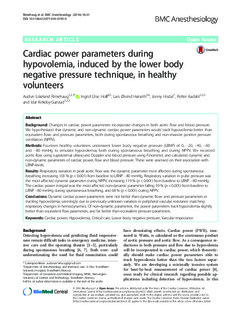| dc.contributor.author | Rimehaug, Audun Eskeland | |
| dc.contributor.author | Hoff, Ingrid E Taraldsrud | |
| dc.contributor.author | Høiseth, Lars Øivind | |
| dc.contributor.author | Hisdal, Jonny | |
| dc.contributor.author | Aadahl, Petter | |
| dc.contributor.author | Kirkeby-Garstad, Idar | |
| dc.date.accessioned | 2016-08-02T07:46:04Z | |
| dc.date.accessioned | 2016-08-04T06:48:13Z | |
| dc.date.available | 2016-08-02T07:46:04Z | |
| dc.date.available | 2016-08-04T06:48:13Z | |
| dc.date.issued | 2016 | |
| dc.identifier.citation | BMC Anesthesiology 2016 | nb_NO |
| dc.identifier.issn | 1471-2253 | |
| dc.identifier.uri | http://hdl.handle.net/11250/2397748 | |
| dc.description.abstract | Background: Changes in cardiac power parameters incorporate changes in both aortic flow and blood pressure.
We hypothesized that dynamic and non-dynamic cardiac power parameters would track hypovolemia better than
equivalent flow- and pressure parameters, both during spontaneous breathing and non-invasive positive pressure
ventilation (NPPV).
Methods: Fourteen healthy volunteers underwent lower body negative pressure (LBNP) of 0, −20, −40, −60
and −80 mmHg to simulate hypovolemia, both during spontaneous breathing and during NPPV. We recorded
aortic flow using suprasternal ultrasound Doppler and blood pressure using Finometer, and calculated dynamic and
non-dynamic parameters of cardiac power, flow and blood pressure. These were assessed on their association with
LBNP-levels.
Results: Respiratory variation in peak aortic flow was the dynamic parameter most affected during spontaneous
breathing increasing 103 % (p < 0.001) from baseline to LBNP −80 mmHg. Respiratory variation in pulse pressure was
the most affected dynamic parameter during NPPV, increasing 119 % (p < 0.001) from baseline to LBNP −80 mmHg.
The cardiac power integral was the most affected non-dynamic parameter falling 59 % (p < 0.001) from baseline to
LBNP −80 mmHg during spontaneous breathing, and 68 % (p < 0.001) during NPPV.
Conclusions: Dynamic cardiac power parameters were not better than dynamic flow- and pressure parameters at
tracking hypovolemia, seemingly due to previously unknown variation in peripheral vascular resistance matching
respiratory changes in hemodynamics. Of non-dynamic parameters, the power parameters track hypovolemia slightly
better than equivalent flow parameters, and far better than equivalent pressure parameters. | nb_NO |
| dc.language.iso | eng | nb_NO |
| dc.publisher | BioMed Central | nb_NO |
| dc.rights | Navngivelse 3.0 Norge | * |
| dc.rights.uri | http://creativecommons.org/licenses/by/3.0/no/ | * |
| dc.title | Cardiac power parameters during hypovolemia, induced by the lower body negative pressure technique, in healthy volunteers | nb_NO |
| dc.type | Journal article | nb_NO |
| dc.type | Peer reviewed | nb_NO |
| dc.date.updated | 2016-08-02T07:46:04Z | |
| dc.source.journal | BMC Anesthesiology | nb_NO |
| dc.identifier.doi | 10.1186/s12871-016-0195-0 | |
| dc.identifier.cristin | 1370029 | |
| dc.description.localcode | © 2016 Rimehaug et al. Open Access This article is distributed under the terms of the Creative Commons Attribution 4.0 | nb_NO |

